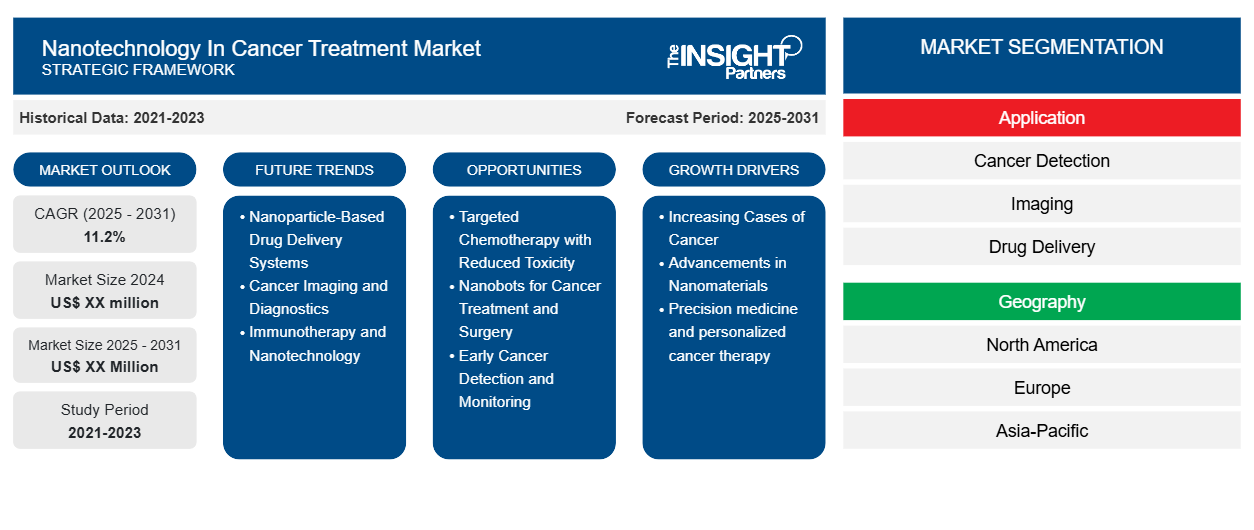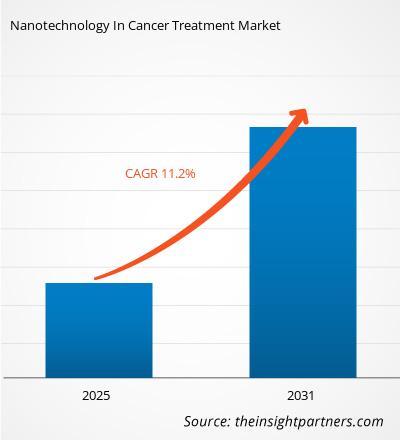The Nanotechnology In Cancer Treatment Market is expected to register a CAGR of 11.2% from 2025 to 2031, with a market size expanding from US$ XX million in 2024 to US$ XX Million by 2031.
The report is segmented by Application (Cancer Detection, Imaging, Drug Delivery, Radiotherapy, Immunotherapy, Phototherapy). The report is segmented by End User (Home Care, Hospital, Others). The global analysis is further broken-down at regional level and major countries. The Report Offers the Value in USD for the above analysis and segments.
Purpose of the Report
The report Nanotechnology In Cancer Treatment Market by The Insight Partners aims to describe the present landscape and future growth, top driving factors, challenges, and opportunities. This will provide insights to various business stakeholders, such as:
- Technology Providers/Manufacturers: To understand the evolving market dynamics and know the potential growth opportunities, enabling them to make informed strategic decisions.
- Investors: To conduct a comprehensive trend analysis regarding the market growth rate, market financial projections, and opportunities that exist across the value chain.
- Regulatory bodies: To regulate policies and police activities in the market with the aim of minimizing abuse, preserving investor trust and confidence, and upholding the integrity and stability of the market.
Nanotechnology In Cancer Treatment Market Segmentation
Application
- Cancer Detection
- Imaging
- Drug Delivery
- Radiotherapy
- Immunotherapy
- Phototherapy
You will get customization on any report - free of charge - including parts of this report, or country-level analysis, Excel Data pack, as well as avail great offers and discounts for start-ups & universities
Nanotechnology In Cancer Treatment Market: Strategic Insights

-
Get Top Key Market Trends of this report.This FREE sample will include data analysis, ranging from market trends to estimates and forecasts.
Nanotechnology In Cancer Treatment Market Growth Drivers
- Increasing Cases of Cancer: The increasing cases of cancer have emerged as one of the major driving forces for applications of nanotechnology in the curing of cancer. This has emerged to be one of the biggest killers across the globe, and according to the World Health Organization, it has been estimated to kill nearly 9.6 million people every year. These sectors vulnerable to aging, unhealthy lifestyle, and environmental influences push the cancer cases into upward trends. The nature of the disorder has thus made it an emerging need for new and effective treatment alternatives. Advances in nanotechnology bring about targeted, efficient, less invasive solutions against cancer, thereby responding to this increasing burden.
- Advancements in Nanomaterials: Advances in nanomaterials, which include gold nanoparticles, liposomes, dendrimers, and carbon nanotubes, are a driving force behind tremendous growth in the nanotechnology-based cancer treatment market. Such nanomaterials acquire the apt properties for use as a drug delivery and imaging tool, high surface area, biocompatibility, and ability to cross cellular membranes. For instance, nanomaterials have been synthesized for clinical application use to enhance the solubility, stability, and bioavailability of chemotherapeutic drugs while having a better control over the release of those drugs without the manifestation of toxic side effects.
- Precision medicine and personalized cancer therapy: The novel therapy of precision medicine, that is, tailoring the treatment to the actual genetic makeup and characteristic traits of tumors, has increased the demand for targeted therapies against various cancers. Nanotechnology holds a very key position in the implementation of personalized treatments. Such an ability to engineer nanoparticles to selectively interact with cancerous cells based upon the signatures of their molecular makeup has resulted in less damage to healthy tissues and enhanced therapy outcomes. It can also aid in overcoming some of the challenges associated with drug resistance, which remains a key driver for further nanotechnology development in the treatment of cancer.
Nanotechnology In Cancer Treatment Market Future Trends
- Nanoparticle-Based Drug Delivery Systems: The other emerging trend in treating cancer is nanoparticles being increasingly used as drug delivery systems. Chemotherapy, as administered by conventional methods, generally results in nonspecific, hence systemic toxicity which leads to unwanted side effects. Nanoparticles can, however, be engineered to deliver drugs selectively to the tumor site improving therapeutic efficacy while reducing side effects. Liposomes, micelles, and dendrimers are some of the leading types of nanoparticle carriers and lead drug delivery systems for the treatment of drugs in a controlled manner and targeting, with the field being the focal point of research and clinical trials undertaken in oncology.
- Cancer Imaging and Diagnostics: Cancer diagnosis is being revolutionized by nanotechnology through improved techniques of imaging. Scientists are actively researching the use of nanoparticles as contrast agents for imaging modalities such as MRI, CT, and PET. These contrast agents will assist in the earlier, more accurate detection of tumors. Quantum dots, gold nanoparticles, and superparamagnetic iron oxide nanoparticles are areas in which researchers are truly optimistic about their sensitivities and specificity in diagnostic imaging. It may contribute to earlier intervention and better results.
- Immunotherapy and Nanotechnology: Cancer treatment is also witnessing the growth of the trend by immunotherapy, that activates body's immune response to fight against cancer. Nanotechnology has made significant contributions toward the success in cancer immunotherapies, as it enhances drug delivery and the effectiveness of immunotherapeutic agents. Nanoparticles are useful for the delivery of immune checkpoint inhibitors, cancer vaccines, and cytokines at sites of the tumor for enhanced immune response with reduced side effects. This is fast becoming a hot trend in developing combination therapies that combine immunotherapy with others more traditional treatments.
Nanotechnology In Cancer Treatment Market Opportunities
- Targeted Chemotherapy with Reduced Toxicity: One very important application of nanotechnology in cancer treatment is about its promise of delivering more targeted chemotherapy with lower toxicity. Nanoparticles can be engineered to bind only to particular cell surface markers that characterize cancer cells. This would reduce the chemotherapy dose released to normal tissues. This precision will allow for the potential to significantly enhance the quality and outcomes of life for patients and reduce the severity of chemotherapy adverse effects.
- Nanobots for Cancer Treatment and Surgery: Nanobots for Cancer Treatment and Surgery Nanorobots, or "nanobots" as they are sometimes called, represent the cutting edge of new applications in medicine, including a new approach in the treatment of cancer. These microscopic robots may be programmed to seek out cancer cells and destroy them or to carry drugs straight to the site of the tumor. In the application of minimally invasive surgery, another possible use of nanobots could be-not a procedure that requires traditional surgical techniques. This field is not full steam ahead yet but will definitely have the cancer treatment perspective change in a whole new direction.
- Early Cancer Detection and Monitoring: Highly Sensitivity Biosensors and Diagnostic Platforms Nanotechnology is promising to be a tool for highly sensitive biosensors and diagnostic platforms that would be helpful for early cancer diagnosis. Particles can be designed to detect particular biomarkers associated with cancer, and that will assist in making non-invasive, fast, and very accurate early diagnoses. Nanotechnology application may also be utilized in tracking the in-time progression of treatment responses wherein clinicians may ascertain the effectiveness of therapy given the patient's response and it improves the outcome.
Nanotechnology In Cancer Treatment Market Regional Insights
The regional trends and factors influencing the Nanotechnology In Cancer Treatment Market throughout the forecast period have been thoroughly explained by the analysts at The Insight Partners. This section also discusses Nanotechnology In Cancer Treatment Market segments and geography across North America, Europe, Asia Pacific, Middle East and Africa, and South and Central America.
Nanotechnology In Cancer Treatment Market Report Scope
| Report Attribute | Details |
|---|---|
| Market size in 2024 | US$ XX million |
| Market Size by 2031 | US$ XX Million |
| Global CAGR (2025 - 2031) | 11.2% |
| Historical Data | 2021-2023 |
| Forecast period | 2025-2031 |
| Segments Covered |
By Application
|
| Regions and Countries Covered |
North America
|
| Market leaders and key company profiles |
|
Nanotechnology In Cancer Treatment Market Players Density: Understanding Its Impact on Business Dynamics
The Nanotechnology In Cancer Treatment Market is growing rapidly, driven by increasing end-user demand due to factors such as evolving consumer preferences, technological advancements, and greater awareness of the product's benefits. As demand rises, businesses are expanding their offerings, innovating to meet consumer needs, and capitalizing on emerging trends, which further fuels market growth.

- Get the Nanotechnology In Cancer Treatment Market top key players overview
Key Selling Points
- Comprehensive Coverage: The report comprehensively covers the analysis of products, services, types, and end users of the Nanotechnology In Cancer Treatment Market, providing a holistic landscape.
- Expert Analysis: The report is compiled based on the in-depth understanding of industry experts and analysts.
- Up-to-date Information: The report assures business relevance due to its coverage of recent information and data trends.
- Customization Options: This report can be customized to cater to specific client requirements and suit the business strategies aptly.
The research report on the Nanotechnology In Cancer Treatment Market can, therefore, help spearhead the trail of decoding and understanding the industry scenario and growth prospects. Although there can be a few valid concerns, the overall benefits of this report tend to outweigh the disadvantages.
Frequently Asked Questions
Which segment accounts for highest revenue by application in 2023?
What is the expected CAGR of the Nanotechnology In Cancer Treatment Market ?
What are the driving factors impacting the Nanotechnology In Cancer Treatment market?
1. Increasing Cases of Cancer
2. Advancements in Nanomaterials
What are the factor that act as a opportunity for market growth?
Which region dominated the Nanotechnology In Cancer Treatment market in 2023?
Which are some of the players operating in the Nanotechnology In Cancer Treatment market?
- Historical Analysis (2 Years), Base Year, Forecast (7 Years) with CAGR
- PEST and SWOT Analysis
- Market Size Value / Volume - Global, Regional, Country
- Industry and Competitive Landscape
- Excel Dataset
Recent Reports
Related Reports
Testimonials
Reason to Buy
- Informed Decision-Making
- Understanding Market Dynamics
- Competitive Analysis
- Identifying Emerging Markets
- Customer Insights
- Market Forecasts
- Risk Mitigation
- Boosting Operational Efficiency
- Strategic Planning
- Investment Justification
- Tracking Industry Innovations
- Aligning with Regulatory Trends





















 Get Free Sample For
Get Free Sample For